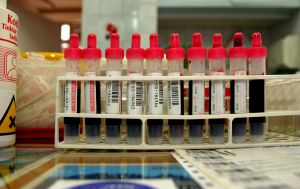In the next lesson, we'll learn how to compare the means of two independent populations, but there may be occasions in which we are interested in comparing the means of two dependent populations. For example, suppose a researcher is interested in determining whether the mean IQ of the population of first-born twins differs from the mean IQ of the population of second-born twins. She identifies a random sample of \(n\) pairs of twins, and measures \(X\), the IQ of the first-born twin, and \(Y\), the IQ of the second-born twin. In that case, she's interested in determining whether:
\(\mu_X=\mu_Y\)
or equivalently if:
\(\mu_X-\mu_Y=0\)
Now, the population of first-born twins is not independent of the population of second-born twins. Since all of our distributional theory requires the independence of measurements, we're rather stuck. There's a way out though... we can "remove" the dependence between \(X\) and \(Y\) by subtracting the two measurements \(X_i\) and \(Y_i\) for each pair of twins \(i\), that is, by considering the independent measurements
\(D_i=X_i-Y_i\)
Then, our null hypothesis involves just a single mean, which we'll denote \(\mu_D\), the mean of the differences:
\(H_0=\mu_D=\mu_X-\mu_Y=0\)
and then our hard work is done! We can just use the \(t\)-test for a mean for conducting the hypothesis test... it's just that, in this situation, our measurements are differences \(d_i\) whose mean is \(\bar{d}\) and standard deviation is \(s_D\). That is, when testing the null hypothesis \(H_0:\mu_D=\mu_0\) against any of the alternative hypotheses \(H_A:\mu_D \neq \mu_0\), \(H_A:\mu_D<\mu_0\), and \(H_A:\mu_D>\mu_0\), we compare the test statistic:
\(t=\dfrac{\bar{d}-\mu_0}{s_D/\sqrt{n}}\)
to a \(t\)-distribution with \(n-1\) degrees of freedom. Let's take a look at an example!
Example 10-3 Section

Blood samples from \(n=10\) = 10 people were sent to each of two laboratories (Lab 1 and Lab 2) for cholesterol determinations. The resulting data are summarized here:
| Subject | Lab 1 | Lab 2 | Diff |
|---|---|---|---|
|
1 |
296 | 318 | -22 |
| 2 | 268 | 287 | -19 |
| . | . | . | . |
| . | . | . | . |
| . | . | . | . |
| 10 | 262 | 285 | -23 |
| \(\bar{x}_{1}=260.6\) | \(\bar{x}_{2}=275\) | \(\begin{array}{c} \bar{d}=-14.4 \\ s_{d}=6.77 \end{array}\) |
Is there a statistically significant difference at the \(\alpha=0.01\) level, say, in the (population) mean cholesterol levels reported by Lab 1 and Lab 2?
Answer
The null hypothesis is \(H_0:\mu_D=0\), and the alternative hypothesis is \(H_A:\mu_D\ne 0\). The value of the test statistic is:
\(t=\dfrac{-14.4-0}{6.77/\sqrt{10}}=-6.73\)
The critical region approach tells us to reject the null hypothesis at the \(\alpha=0.01\) level if \(t>t_{0.005, 9}=3.25\) or if \(t<t_{0.005, 9}=-3.25\). Therefore, we reject the null hypothesis because \(t=-6.73<-3.25\), and therefore falls in the rejection region.
Again, we draw the same conclusion when using the \(p\)-value approach. In this case, the \(p\)-value is:
\(p-\text{value }=2\times P(T_9<-6.73)\le 2\times 0.005=0.01\)
As expected, we reject the null hypothesis because \(p\)-value \(\le 0.01=\alpha\).
And, the Minitab output for this example looks like this:
| N | Mean | StDev | SE Mean | 95% CI | T | P |
|---|---|---|---|---|---|---|
| 10 | -14.4000 | 6.7700 | 2.1409 | (-19.2430, -9.5570) | -6.73 | 0.000 |